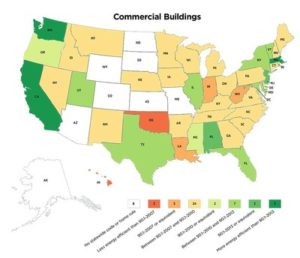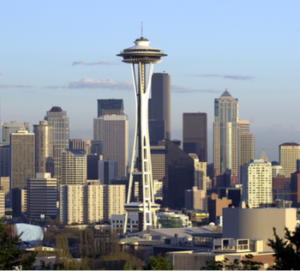Already the most rigorous in the US, the 2015 Washington State Energy Code contains section C406 with eight “additional efficiency package options” to provide a flexible way for projects to comply and take energy efficiency to the next level. The code requires new commercial buildings to incorporate two efficiency options, spurring the state towards its mandate to reduce building energy use 70% by 2031.
- Category
- Energy
- Subcategory
- Energy Efficiency
- Adopted By
- State of Washington
- Applies To
- New Commercial Buildings
- Owned By
- Washington State Dept. of Commerce
- Managed By
- Washington State Building Codes Council
- Participation
- Year of Adoption
- 2012
- Current Version
- 2015
- Update Cycle
- Every 3 years
- Recent Action
- Became Effective July 1, 2016
- Code/Policy
- WSEC Section C406 – Commercial Energy Efficiency Options
- Pursuant to
- Washington State Energy Code Section C406, Page C-93
- Referenced
- RCW 19.27A.160 - reduction of energy consumption in
Since 2009, the WA State Energy code has increased requirements for insulation, fenestration and building envelope tightness, mechanical systems, water heating, power and lighting efficiency to meet its mandate under RCW 19.27A 160. The law says the code shall require a 70% reduction in building energy use by 2031 – using the 2006 energy code as a baseline – tasking the State Building Codes Council (SBCC) to adopt incremental improvements averaging about 19% better energy efficiency per 3-year code cycle. By 2012, most of the “low-hanging fruit” opportunities to improve efficiency had been “harvested” so the SBCC had to get creative to find additional ways to reduce building energy use. Section C406 of the 2015 Washington State Energy Code incorporates eight “Additional Efficiency Package Options”, two of which are required by code to be installed in every new construction commercial building or tenant improvement project.
| Policy Title | Purpose of Policy |
|---|---|
| Washington State Energy Code Section C406—Additional efficiency package options (see page C-93) | The purpose of the C406 Additional efficiency package options is to make efficiency improvements standard. Also, the SBCC and the Washington State Dept. of Commerce must meet all cost-effective means of reduction of energy consumption by 70% in 2030. |
The International Code Council first incorporated the new Section C406 in its 2012 International Energy Efficiency Code revision, but Washington first adopted efficiency options as part of the 2009 Washington State Energy Code, residential section, allowing builders to mix and match efficiency measures from a diverse list of options. The Building Industry Association of Washington sued the state challenging the provision on the basis that it exceeded federal standards, but the court upheld the option table in 2011.
It wasn’t until the 2015 code that Washington state adopted it into the commercial energy code provisions (which became effective July 1 2016). While the IECC requires one option to be selected from a list of six, Washington took it a step further, requiring two options to be selected from a list of 8 including additional options to provide building professionals more flexibility to pick the pathways that best suit their projects, but requiring a higher level of energy efficiency.
Organizations in the green tech engineering community such as the New Buildings Institute, Ecotope and the Pacific Northwest National Laboratory have been creating solutions and driving much of the innovation in this space, and were behind adoption of C406. New Buildings Institute developed the original list, and they performed the analysis and the measurements. Washington State Building Codes Council reviewed them and added a couple options.
This code applies to new commercial buildings, associated systems and equipment, and is intended to improve the “use and conservation of energy over the life of each building.” The energy code is further intended to “provide flexibility to permit the use of innovative approaches and techniques.” The city or county (or its designated enforcement agency) enforces the code or require the building owner to hire a certified nonresidential energy special inspector to perform the plan review and/or field inspection.
To drive compliance the code offers options that are applicable to a range of buildings. As of 2016 Washington is the only state to mandate selection of two options to comply. Options are important because achievable compliance paths vary depending on building use, type, and location. For example, reducing lighting power density by 25% can be tough depending on the size of the space.
 The energy code for commercial buildings sets minimum prescriptive requirements for the building envelope, mechanical systems, and lighting installations. Plans and specifications must be submitted unless otherwise required by the building official. Compliance is determined by plan review and inspection by the local building official. For complicated design work, a professional energy study may be required and approved. Field inspections are required before a Certificate of Occupancy is issued. The building official is the key holder to approval of projects and may look to SBCC for clarification on any codes, including C406.
The energy code for commercial buildings sets minimum prescriptive requirements for the building envelope, mechanical systems, and lighting installations. Plans and specifications must be submitted unless otherwise required by the building official. Compliance is determined by plan review and inspection by the local building official. For complicated design work, a professional energy study may be required and approved. Field inspections are required before a Certificate of Occupancy is issued. The building official is the key holder to approval of projects and may look to SBCC for clarification on any codes, including C406.
It is important to note that technologies that are used to meet one code, cannot be used again to meet another. For example, C805 cannot be applied to Option 4 of C406. Also, first-time tenant improvements in new multi-tenant buildings have to select one credit, unless the shell and core permit used the renewable energy, enhanced envelope performance, or reduced air infiltration options. (See C406.1.1)
| “The Development of the Residential Option Table in the Washington State Energy Code” by David Baylon, Ecotope, Inc. Chuck Murray, Washington State Department of Commerce, 2016, ACEEE Summer Study on Energy Efficiency | “The Economic Impacts and Macroeconomic Benefits of Energy Efficiency Programs in Washington” by Robert Whelan, Tessa Krebs, and Tina Morgan. ECONorthwest. Web. 9 Feb. 2017 |
| US Department of Energy – Status of Energy Code Adoption – Washington. | “Commercial Code Evaluation Pilot Study Final Report,”by Poppy Storm, David Baylon, Benjamin Hannas, and John Hogan. Northwest Energy Efficiency Alliance, 14 Apr. 2016. Web. |
The Eight Efficiency Package Options are:
- More efficient HVAC – Sets higher minimum efficiencies for Heating, Ventilation and Air Conditioning components.
- Reduction in Lighting – Takes lighting to 25% below the original baseline and requires all fixtures to deliver 70 or more lumens per watt.
- Enhanced Lighting Controls – Each fixture is individually addressed with continuous dimming, daylighting controls and occupancy sensors.
- On Site Supply of Renewable Energy – The building must have an onsite renewable energy system that provides a specified power requirement per square foot of space type.
- Dedicated Outdoor Air Supply – Instead of a VAV system a DOAS system dedicates outdoor air for latent loads.
- High Efficiency Service Water Heating – High efficiency water heating through technology such as reverse cycle chiller or heat pump commercial water heating system.
- Enhanced Envelope Performance – Total UA allowance for the building is reduced to 15% below the baseline. This can be accomplished through technologies such as vapor barriers and mineral wool on the external side of the building.
- Reduction of Air Infiltration – Accomplished by reducing the leakiness of the building.
Based upon the original proposal submitted by the New Buildings Institute they estimate 3.4 kBTU per square foot of annual energy savings with an average energy use reduction from a typical Washington building of 5.5%.
The Northwest knows that energy efficiency is good for business and have made it a priority to take the built environment into the future of energy efficiency. The Northwest Energy Efficiency Council (NEEC)’s 2014 financial study “The economic impacts and micro economic benefits of energy efficiency programs in Washington” shows that dollars invested in energy efficiency raise economic productivity and elevate the standard of living in many ways. The study used sophisticated IPLAN software to track the life cycle of dollars saved by conservation method. They concluded that money saved by conservation energy usually remains in state and is often directed towards creating jobs and promoting innovation on the microeconomic level. Productivity improvements, reductions in production costs, lower prices, higher standards of living, and capacity expansions are identified as some of the positive effects.
There were some difficulties with early incarnations of the code section due to potential legal complication regarding Federal regulations prohibiting recommendations of certain appliances versus others. But the law ultimately sided with the state in their effort to provide more efficient options to consumers, if the options are given as a broad list of alternatives.
Looking forward it will be difficult to cultivate additional policies such as C406 that drive deeper energy code baseline reduction. The key issue will be cost effectiveness, as the state can impose requirements but cannot impose provisions that are not deemed cost effective. No doubt the frontiers of code development will continue to seek out new cost effective means of conservation and we will rely upon the innovative thinkers and industry leaders to develop additional forms or adoption to complete carbon neutrality.
The cost of code-required energy efficiency measures are borne by the builder and passed on to the consumer. Utility incentives are not typically available for anything that’s already required by code, but may be available for measures that go beyond what is required. So to qualify a builder must include energy efficiency measures not included in the chosen options, or go beyond the baselines set by that selected option. For example, in a new construction multifamily project, under what is called the “The Built Smart” program through Seattle City Light’s division of Customer Energy Services, if a developer chooses the Option C406.3 for reduced consumption through lighting, the effect of that option must be factored in to the baseline calculation. So for the lighting efficiency to qualify for incentives, they must go beyond the baseline (including the selected lighting option) to receive energy efficiency incentive funding based upon the net energy savings beyond the code requirement. Incentives are subject to change as code requirements change, or in response to new data from studies on energy savings.
In additional to efficiency incentives, utilities administer the Washington State Department of Revenue Renewable Energy System Cost Recovery Incentive Payments, with funds not from rate payers, but rather from the Washington Department of Revenue through the Washington Administrative Code of 458-20-273. This incentive was set to sunset in 2020, but as of July 3, 2017 the Senate and House passed SB 5939 to stabilize the incentive through 2030. Click for more info on the bill’s history as well as the final bill itself.
Additional Funding opportunities can be researched through the Dsire online tool offered by the NC Clean Energy Technology Center.
Senior Energy Policy Analyst
Energy Code Advisor
